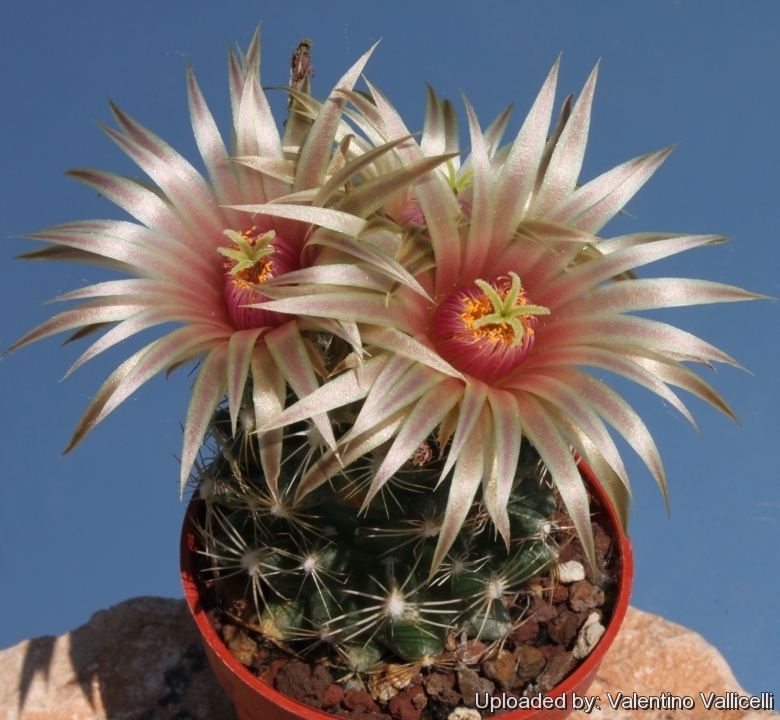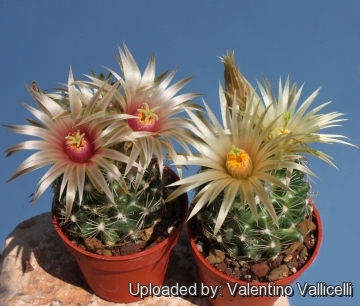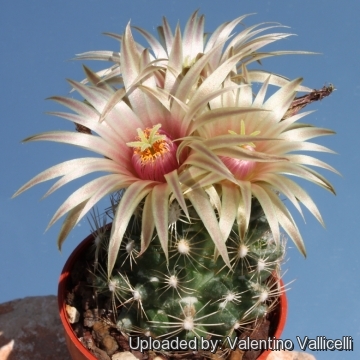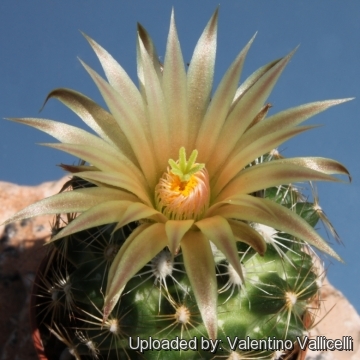




Your support is critical to our success.
Accepted Scientific Name: Escobaria missouriensis (Sweet) D.R.Hunt
Cact. Succ. J. Gr. Brit. 40(1): 13 (1978) Remarks: sp. nov. for Cactus mammillaris sensu Nuttall (Gen. N. Amer. Pl. 1: 295. 1818), non Linnaeus (1753)

Montgomery Co, Kansas, USA
Origin and Habitat: Kansas, Oklahoma, Colorado and Texas, USA
Synonyms:
- Escobaria missouriensis var. caespitosa (Engelm.) D.R.Hunt
- Coryphantha missouriensis var. caespitosa (Engelm.) L.D.Benson
- Mammillaria missouriensis var. caespitosa (Engelm.) S.Watson
- Mammillaria nuttallii var. caespitosa (Engelm.) Engelm.
- Mammillaria similis var. caespitosa Engelm.
Escobaria missouriensis (Sweet) D.R.Hunt
Cact. Succ. J. Gr. Brit. 40(1): 13 (1978) Remarks: sp. nov. for Cactus mammillaris sensu Nuttall (Gen. N. Amer. Pl. 1: 295. 1818), non Linnaeus (1753)
Synonymy: 54
- Escobaria missouriensis (Sweet) D.R.Hunt
- Cactus missourensis (Sweet) Kuntze
- Coryphantha missouriensis (Sweet) Britton & Rose
- Mammillaria missouriensis Sweet
- Neobesseya missouriensis (Sweet) Britton & Rose
- Neomammillaria missouriensis (Sweet) Britton & Rose ex Rydb.
- Escobaria missouriensis subs. asperispina (Boed.) N.P.Taylor
- Coryphantha asperispina Boed.
- Escobaria asperispina (Boed.) D.R.Hunt
- Escobaria missouriensis var. asperispina (Boed.) N.P.Taylor
- Neobesseya asperispina (Boed.) Boed.
- Escobaria missouriensis var. caespitosa (Engelm.) D.R.Hunt
- Coryphantha missouriensis var. caespitosa (Engelm.) L.D.Benson
- Mammillaria missouriensis var. caespitosa (Engelm.) S.Watson
- Mammillaria nuttallii var. caespitosa (Engelm.) Engelm.
- Mammillaria similis var. caespitosa Engelm.
- Escobaria missouriensis var. marstonii (Clover) D.R.Hunt
- Coryphantha marstonii Clover
- Coryphantha missouriensis var. marstonii (Clover) L.D.Benson in L.D.Benson
- Escobaria missouriensis subs. navajoensis Hochstätter
- Neobesseya arizonica (Engelm. in W.H.Brewer & S.Watson) Hester
- Escobaria missouriensis var. notesteinii (Engelm.)
- Cactus notesteinii (Britton) Rydb.
- Coryphantha notesteinii (Britton) H.P.Kelsey & Dayton
- Mammillaria notesteinii Britton
- Neobesseya notesteinii (Britton) Britton & Rose
- Escobaria missouriensis var. nuttallii (Engelm.)
- Coryphantha nuttallii Engelm. ex Förster
- Mammillaria missouriensis var. nuttallii Schelle
- Mammillaria nuttallii Engelm.
- Neobesseya nuttallii (Engelm.) Borg
- Escobaria missouriensis var. nuttallii f. borealis (Engelm.)
- Escobaria missouriensis var. robustior (Engelm.) D.R.Hunt
- Cactus missourensis var. robustior (Engelm.) J.M.Coult.
- Cactus robustior (Engelm.) Small
- Coryphantha missouriensis var. robustior (Engelm.) L.D.Benson
- Mammillaria missouriensis var. robustior (Engelm.) S.Watson
- Mammillaria nuttallii var. robustior Engelm.
- Mammillaria similis var. robustior Engelm.
- Escobaria missouriensis var. roseiflora (Lahman ex Turner)
- Neobesseya roseiflora Lahman ex Turner
- Escobaria missouriensis var. similis (Engelm. & A.Gray) N.P.Taylor
- Cactus similis (Engelm. & A.Gray) Small
- Coryphantha similis (Engelm. & A.Gray) Britton & Rose
- Escobaria similis (Engelm. & A.Gray) hort.
- Mammillaria missouriensis var. similis (Engelm. & A.Gray) S.Watson ex K.Schum.
- Mammillaria similis Engelm. & A.Gray
- Neobesseya missouriensis subs. similis (Engelm. & A.Gray) Doweld
- Neobesseya similis (Engelm. & A.Gray) Britton & Rose
- Escobaria wissmannii (Hildm. ex K.Schum.) hort.
- Coryphantha wissmannii (Hildm. ex K.Schum.) A.Berger
- Mammillaria wissmannii Hildm. ex K.Schum.
- Neobesseya wissmannii (Hildm. ex K.Schum.) Britton & Rose
Description: Escobaria missouriensisSN|9953]]SN|10274]] var. caespitosa is one of the many form of the variable Escobaria missouriensisSN|10274]]SN|10274]] that may forms clumps up to 30 cm in diameter. It is not easily separable by any character from the the other Escobaria missouriensisSN|10274]]SN|10274]].
Roots: Diffuse or short taproots, sometimes adventitious from bases of branches.
Stems: Deep-seated in substrate, becoming flat-topped and nearly subterranean in winter, 2-8 wide × 1-10 cm tall;
Tubercles: 5-21 soft; areolar glands absent;
Areoles: With short white wool, not obscuring the basal portion of the spine.
Spines: 6-21 per areole, slightly pubescent, bright white, pale grey, or pale tan, weathering to grey or yellowish brown, dark brownish orange to pale brown or pale greyish pink tips present on all or only the largest plants;
Radial spines: 6-20 per areole, moderately to tightly appressed, 4-16 mm
Central spines: 0(-3) per areole, if 1, erect, if 2, ascending-spreading, 8-20 mm long.
Flowers: Nearly apical, 18-50 mm long, 15-50 mm wide tepals, fringed (rarely entire), pale greenish yellow to yellow-green, with midstripes of green or rose-pink to pale brown
Filaments: Brighter pink than inner tepals, pinkish with greenish white bases, or uniformly whitish;
Anthers: Bright yellow;
Stigma lobes: 3-7, green or yellowish, 1-5 mm.
Fruits: Bright orange-red to scarlet when mature, spheric to ellipsoid, 5-10 mm, slightly succulent but not juicy, floral remnant weakly persistent, often lost through weathering.
Remarks: At first glance it seems very much like Escobaria viviparaSN|10274]]SN|9953]] but the strange copper flower colour and brightly coloured fruit will quickly distinguish it. Though not exactly showy, the straw-yellow, brown, or amber flowers are quite appealing, as are the bright red fruit that persist from late summer to spring. It is variable over its huge range, and worth obtaining in various forms.
Subspecies, varieties, forms and cultivars of plants belonging to the Escobaria missouriensis group
 Escobaria missouriensis (Sweet) D.R.Hunt: (ssp. missouriensis) Tubercles 6-9 mm long, 10-20 radial spines, and yellow or pink flowers. Distribution: Ranges from Idaho to North Dakota, south on the Great Plains to Nebraska, and in the Rocky Mountains and Colorado Plateaus to New Mexico and Arizona
Escobaria missouriensis (Sweet) D.R.Hunt: (ssp. missouriensis) Tubercles 6-9 mm long, 10-20 radial spines, and yellow or pink flowers. Distribution: Ranges from Idaho to North Dakota, south on the Great Plains to Nebraska, and in the Rocky Mountains and Colorado Plateaus to New Mexico and Arizona- Escobaria missouriensis subs. asperispina (Boed.) N.P.Taylor: Tubercles to 18 mm long, 9-10 radials, and greenish yellow or cream flowers. Distribution: Southeastern Coahuila and Nuevo Leon.
 Escobaria missouriensis var. caespitosa (Engelm.) D.R.Hunt
Escobaria missouriensis var. caespitosa (Engelm.) D.R.Hunt- Escobaria missouriensis var. marstonii (Clover) D.R.Hunt
 Escobaria missouriensis subs. navajoensis Hochstätter: Plant whith short tubercles (only 2 mm long) and small flowers 2-3 cm in diameter that are yellowish with dark midveins. Distribution: Navajo County, Arizona.
Escobaria missouriensis subs. navajoensis Hochstätter: Plant whith short tubercles (only 2 mm long) and small flowers 2-3 cm in diameter that are yellowish with dark midveins. Distribution: Navajo County, Arizona. Escobaria wissmannii (Hildm. ex K.Schum.) hort.: It is not easily separable by any character from Escobaria missouriensis. Distribution: Texas
Escobaria wissmannii (Hildm. ex K.Schum.) hort.: It is not easily separable by any character from Escobaria missouriensis. Distribution: Texas
Bibliography: Major references and further lectures
1) Edward Anderson “The Cactus family” Timber Press, Incorporated, 2001
2) James Cullen, Sabina G. Knees, H. Suzanne Cubey "The European Garden Flora Flowering Plants: A Manual for the Identification of Plants Cultivated in Europe, Both Out-of-Doors and Under Glass" Cambridge University Press, 11/Aug/2011
3) David R Hunt; Nigel P Taylor; Graham Charles; International Cactaceae Systematics Group. "The New Cactus Lexicon" dh books, 2006
4) Jackie M. Poole, William R. Carr, Dana M. Price, Jason R. Singhurst “Rare plants of Texas: a field guide” Texas A&M University Press, 30/Dec/2007

Escobaria missouriensis var. caespitosa Photo by: Valentino Vallicelli

Escobaria missouriensis var. caespitosa Photo by: Valentino Vallicelli

Escobaria missouriensis var. caespitosa Photo by: Valentino Vallicelli
The gallery now contains thousands of pictures, however it is possible to do even more. We are, of course, seeking photos of species not yet shown in the gallery but not only that, we are also looking for better pictures than those already present. Read More...
Cultivation and Propagation: This plant is extremely frost hardy, adapted to dry soils and is quite susceptible to over-watering if kept in a non ventilated place. It comes from an area of summer rainfall.
Growth rate: Slow-growing.
Soil: Grow it in an open mineral, sandy-gritty cactus compost and provide a very good drainage.
Exposure: It is suited for sunny-brightly exposure, but can tolerate light shade. However it will do its best only with lots of sun and become stressed with inadequate light which could result in poor growth and unnatural shape. It has a good heat tolerance.
Watering: Water sparingly and keep it completely dry during winter. Mature individuals easily rot and die especially after transplanting so be extremely cautious with watering. Keep dry in winter or when night temperatures remain below 10° C. Water it less than average if in bigger pots. (but for outdoors cultivation it is very resistant to wet conditions, too).
Fertilization: Feed them once during the growing season with a fertilizer specifically formulated for cactus and succulents (high potash fertilizer with a dilute low nitrogen), including all micro nutrients and trace elements diluted to ½ the strength recommended on the label. They thrive in poor soils and need a limited supplies of fertilizer to avoid the plants developing excess vegetation, which is easily attacked by fungal diseases.
Special need: It is suited for airy exposures. Provide very good ventilation. Nearly all problems occur as a result of overwatering and poor ventilation, especially when weather conditions are dull and cool or very humid. They must have very dry atmosphere.
Hardiness: Very cold resistant, but the frost resistance varies a lot from clone to clone. It can easily be grown outdoors in areas with minimum winter temperatures of -15 -25° (but northern populations are resistant to -35 -45°C). In cultivation it is best to avoid severe freezing temperatures.
Pests & diseases: These cacti may be attractive to a variety of insects, but plants in good condition should be nearly pest-free, particularly if they are grown in a mineral potting-mix, with good exposure and ventilation. Nonetheless, there are several pests to watch for:
- Red spiders: Red spiders may be effectively rubbed up by misting the plants from above.
- Mealy bugs: Mealy bugs occasionally develop aerial into the new leaves and flowers with disfiguring results, but the worst types develop underground on the roots and are invisible except by their effects.
- Scales, thrips and aphids: These insects are rarely a problem.
- Rot: Rot is only a minor problem if the plants are watered and “aired” correctly. If they are not, fungicides won't help all that much.
Propagation: Usually propagated from seeds (seldom produces offsets) or graft. The seeds (no dormancy requirement, they germinate best at 25°C) can be sown in pots of fine, well-drained sandy soil, any time during the spring when temperatures are warm. Cover the seeds with a fine layer of grit and water from below with a fungicide to prevent damping off. For the 1-2 weeks cover the pots with a sheet of glass/clear perspex to keep the humidity levels high. Remove the glass and replace it with light shade-cloth and mist once or twice a day for the next two weeks after which most seeds should have germinated. From then on mistings can be reduced to every second and then every third day as the little plants grow. The seedlings should not be disturbed until they are well rooted after which they can be planted separately in small pots. Sometimes it is grafted to avoid root rot problems as plants grafted on an hardy stock are easy to grow and no special skill is required.
| Your Actions | |
|---|---|
| Back to Escobaria index | |
| Back to Cactaceae index | |
 |
Back to Cacti Encyclopedia index |
Privacy stantement - Terms and conditions - How to cite - About us - Feedback - Donate



